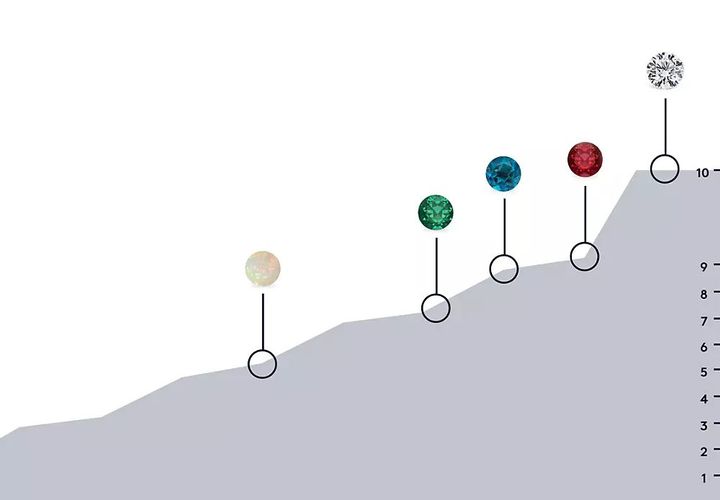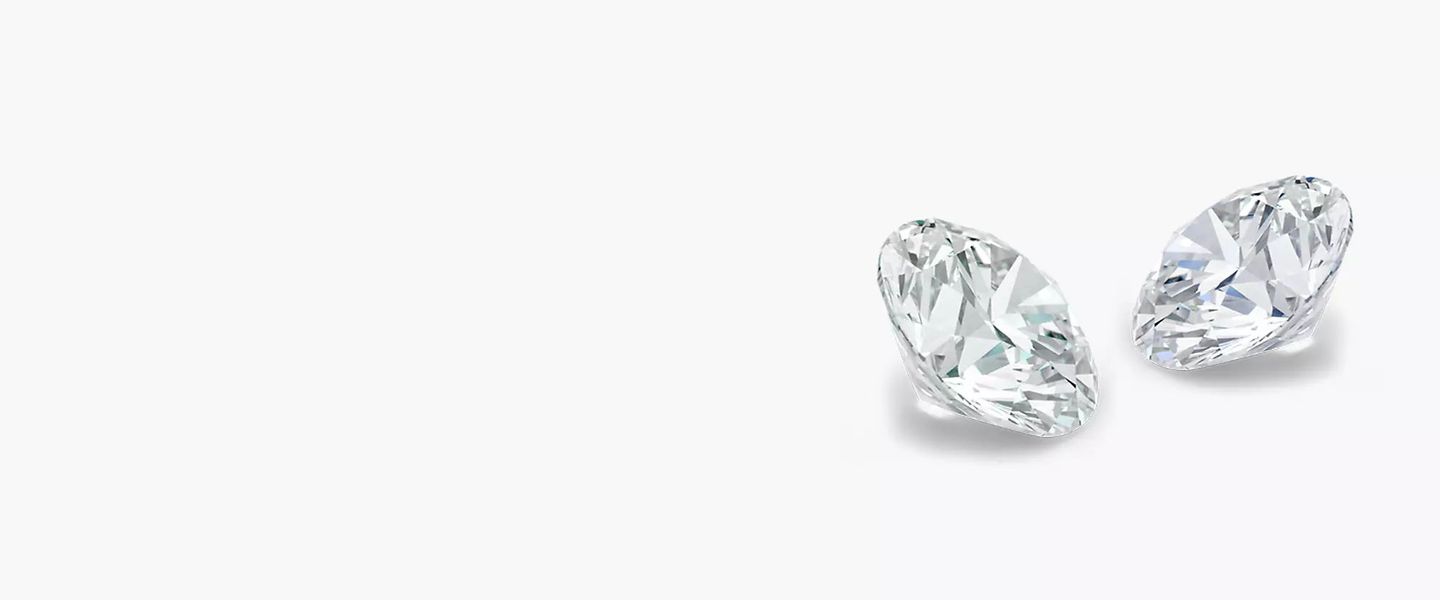Terms and conditions
Origins and Rarity
Diamonds can be found naturally or they can be created in a lab. Diamonds are the hardest substance on earth, made of pure carbon that has undergone intense heat and pressure. However, they are not the rarest gemstone—it is a particular diamond’s color, clarity, carat and, eventually, cut, that makes it uniquely valuable.
Moissanite is very rare to find in nature, as it originates from outer space and is naturally found in meteorites that have landed on Earth. Therefore, most moissanite stones are lab-created and less rare.
Appearance
From a distance, diamonds and moissanites can look quite similar, but as you draw near, the differences become more apparent. One of the fastest ways to tell a diamond apart from a moissanite is to look at the color differences in the brilliance of the stones. A diamond will sparkle with white light while a moissanite will sparkle with rainbow flashes. Known by many as a disco ball effect, some people prefer this moissanite feature while others do not.
Brilliance
Diamonds flaunt a famous sparkle that is widely known and loved, with plenty of fire and refraction to mesmerize. Known as brilliance, the diamond’s sparkle is powered by its facets and cut. Quality cut allows a diamond to bounce and reflect light back to the eye.
Moissanite also offers brilliance that is a result of its higher refractive index. This brings moissanite a dramatic rainbow of hues that make it an attention-grabbing stone.
The choice between the two stones is entirely dependent on the personality and preferences of the wearer.
Color
Diamonds are traditionally colorless, though fancy color diamonds are an increasingly popular choice. A colorless diamond will shine with a white sparkle. Moissanite, on the other hand, is not a true colorless stone. Moissanites can have a tinge of color, such as a gray hue, in certain lighting. Some moissanites may have a yellow hue that resembles a K color grade diamond.
Clarity
Gemstone clarity is important, too. A perfectly flawless diamond is extremely rare and precious. However, many of the inclusions or blemishes in a diamond can be impossible to see without magnification and training. The Gemological Institute of America clarity grading scale is used to sort diamonds according to their clarity.
Due to their lab-created origin, most moissanites are nearly flawless. An average moissanite stone would rank at a desirable “Very Slightly Included,” or “VS” level, using the diamond’s GIA clarity grading scale.
HARDNESS & WEARABILITY
Diamonds are the hardest substance on earth. Scoring an unparalleled 10 on the Mohs Scale, they’re an ideal choice for everyday wear, since they cannot be scratched except by another diamond.
Moissanite features a 9.25 on the Mohs scale, making it very hard and durable as well. It is also resistant to chipping or breaking, making it a fantastic stone for everyday wear.

Enhancements
Gemstones on the market today often undergo one or more enhancements. Diamonds can be treated to enhance or change their color or to improve the appearance of their clarity. HPHT (high-pressure, high-temperature) treatments, heat treatments, irradiation and coatings can give a diamond a new color or enhance its natural hue. Laser drilling can be done to remove imperfections, and fracture filling can fill in white fractures and make them less noticeable.
Meanings and Symbolism
Diamonds are a renowned symbol of love and faithfulness, and they have a long history of use in engagement rings. Colorless diamonds are a sign of purity, and the unparalleled hardness of the diamond makes it a natural symbol of power.
All gemstones have special meaning. Moissanites feature exceptional hardness as well, making them symbolic of the strength of your bond and love. Because natural moissanites come from meteorites originating in space, they also are a sign of connectedness to the universe. They can also be a symbol of unlocking potential, which can bring ongoing meaning as your relationship grows.
Popular Ring Styles and Settings
Diamonds come in a wide range of cuts to showcase the beauty of the stone and suit the wearer’s personality. Cut is different from shape, which describes the outline of the gemstone when you're looking down on it. The cut is all about symmetry, balance, and bringing out a stone’s natural beauty while minimizing its flaws. The classic round cut, elegant square-shaped princess cut, sophisticated cushion cut and vintage-inspired emerald cut are popular for engagement rings. Diamonds sparkle beautifully in virtually any setting type, including 3 diamond rings.
Moissanites, like diamonds, can feature a wide range of cuts, but round cuts best showcase their renowned fire and brilliance. The radiant cut is also dramatic, designed for moissanite to give it an alluring rectangular shape while maximizing its sparkle. The princess cut is a traditional option that showcases the fire of the stone. A more contemporary trillian cut is also a stunning choice, as it enhances the dazzling quality but gives a ring an edgy, modern style. Because of its color differences, moissanite is best in a solitaire ring setting or alongside moissanite stones of similar characteristics.
With such a breathtaking array to choose from, selecting a cut is truly up to the personality and style of the wearer.
More About Diamonds
Diamonds have been the standard-bearer for expressions of love since at least 1477, when the Archduke Maximilian of Austria proposed to his love with the first recorded diamond engagement ring. They have remained the most popular choice for engagement and wedding rings. Diamonds are available in a variety of shapes, sizes and colors.
More About Moissanite
Moissanite is a more recently discovered gemstone, happened upon in 1893 by Henri Moissan when he was examining an Arizona crater left by a meteorite that carried the mineral to Earth. Henri had thought he found diamonds but realized their chemical composition was very different upon closer inspection. Today, moissanites are a popular stone for engagement rings due to their sparkle, durability, lower price tag and likeness to diamonds. Nearly all moissanite engagement rings use lab made stones.
Chemical Differences
When considering the moissanite vs diamond debate from a molecular level, there are a lot of differences between these two stones. Diamonds are comprised of carbon that has been exposed to immense pressure. Moissanite, on the other hand, is made of silicon carbide. Diamonds are created deep in the earth’s crust and can also be created in labs.
Naturally occurring moissanite is only found from meteorites so the majority of moissanite gems for sale are made in a laboratory setting.
Eco-Consciousness
Many people in search of an eco-conscious stone opt for lab-made gems. Moissanite is a lab-made gemstone that’s an increasingly popular choice. Lab made diamonds are also growing in popularity, so both stone types offer an environmentally-conscious option.
Differences in Measuring Moissanite vs Diamonds
Diamonds and moissanites are both measured differently to determine their size. Diamonds are measured by their carat weight. A diamond carat measures how large a diamond is by its weight. Moissanites, on the other hand, are most often measured by their millimeter size rather than their carat weight.
Moissanite vs Diamond Weight
Weight is a quick way to tell a diamond vs a moissanite. Moissanites are lighter than diamonds, with a moissanite stone weighing an average of 15% less than a comparable diamond.
Blue Nile Promise
If you’re still looking for the ring that is quintessentially you, we’re here to offer our expert guidance and stellar services to ensure that you find the ring that is beautifully suited to your taste. To ensure that you feel as thrilled as you should be when making this special purchase, we offer free returns. You can also count on us for complimentary ring sizing to ensure an ideal fit and complimentary cleaning to keep your gemstones sparkling like new. To learn about other gorgeous engagement ring stone options, read our comprehensive gemstone guide.
How Do Other Gemstones Compare to Diamonds?
Gemstone Buying Guide
Gemstone Characteristics
Gemstone Engagement Ring Guide
Gemstones vs Diamond Engagement Rings
Gemstone Meaning
Pearl Buying Guide
Birthstones
Care and Cleaning
Diamond Education and Guidance
Jewelry Education
Ring Education
Metal Education
Only at Blue Nile
When it comes to celebrations we strive to make your experience as
brilliant as our jewelry with the perfect pieces for every occasion.
Meet our personal jewelers, explore bestselling styles, pick up an online order, arrange to preview something from our online collection and so much more.
Book a fun and interactive appointment with a diamond expert and get up-close views of diamond and jewelery options from the comfort of your own home.
Amazing Value
The highest-quality design at a great price.
Peace of Mind
30-day returns, diamond price-match guarantee and more.
Expert Guidance
The original online jeweler since 1999.
Inspiring Assortment
The perfect pieces for every occasion.





